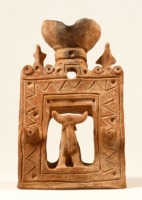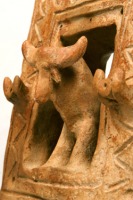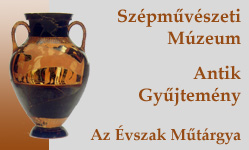Canaanite model shrine
Highlighted Works of Art - 2007 Summer
Highlighted Works of Art - 2007 Summer
 |
 |
The bull figure which dominates the entrance, the horns decorating the walls of the building, and the birds which crown the roof all indicate that the model represents a building with a religious function: a shrine. In all probability, the model does not represent the entire temple, only its most important element, the entrance.
Similar architectural models, decorated with plastically modelled animal and human figures, were made in the second millennium and the beginning of the first millennium BC in northern Mesopotamia and the Levant, in the area of present day Israel, Lebanon, and the coastal region of Syria. The closest parallel for the present object, a similar model shrine which is kept in the Israel Museum in Jerusalem, is also of unknown provenance, but is considered to be of Levantine origin.
In the case of the Budapest piece, further indications support this assumption. The lamp belongs to the pinch-spouted type frequently found in the Levant from the Middle Bronze Age to the Early Iron Age (2100-1200 BC), whereas the modelling of the birds and the bull parallels that of Late Bronze Age and Early Iron Age terracotta and bronze figurines from the area of Syria and Palestine. This leads to the hypothesis that the Budapest piece was made in the Levant sometime during the Late Bronze Age or the Early Iron Age (1600-1000 BC).
At the time the greater part of this area was inhabited by Canaanites speaking a Semitic language related to Hebrew. The Canaanites did not form a unified state, but lived in independent walled cities. Most of these were subject to Egyptian authority in the Late Bronze Age, with their rulers obliged to pay tribute as vassals of the pharaohs. The most well-known settlement is Ugarit (present day Ras Shamra) in the coastal region of northern Syria. Ongoing excavations since the 1920s have brought to light the huge palace of the ruler, the city sanctuaries, and the quarters of the craftsmen and the merchants. The clay tablets inscribed with cuneiform texts which were found in the archives of the palace not only testify to the diplomacy between the great empires of the age, but also constitute our most important sources on Canaanite religion.
 |
El, the father of the gods, usually depicted as a seated man, and his consort, the goddess Asherah stood at the head of the pantheon. The most important divinity of the Canaanites was Baal, most often represented as a standing man with a weapon in his raised right hand, or as a bull. Myths connect his figure with two goddesses: his sister, Anat, the goddess of war, and Astarte, the goddess of love, usually depicted nude and accompanied by her sacred animal, the dove. The two goddesses were identified with Athena and Aphrodite by the Greeks.
The gods of the Canaanite pantheon were worshipped in a variety of ways in the temples and domestic shrines of the different settlements. The common element in religious practice was the sacrificial offering, usually carried out at the altar situated in front of the entrance. In all probability the Biblical description, which differentiates between three kinds of offerings, that of meat, grain, and drink, also goes back to Canaanite tradition (Exod. 29:40-41; Num. 15:1-10; 28-29). Meat was burnt on square altars, grain was offered in the form of flour mixed with oil, while libation consisted of pouring wine from jugs. The offering was accompanied by incense (frankincense and myrrh), with the smells thus issued serving to purify place and participants. Lamps were lit during the ceremony. Lamps and incense-burners may have been placed on separate stands, or-more infrequently-they may have formed one piece. Within the latter category, those in the shape of architectural models, like the piece on display here, are extremely rare.
Ceremonial equipment and votive gifts were placed inside the temple, on benches or on the ground next to the walls. When all the available space was filled, or when the objects were damaged, they were taken to storerooms situated next to the temple, or ritually buried in huge pits (favissae) nearby. The favissa recently unearthed at Yavneh in southern Israel, containing 120 unique stands in the form of model buildings of a previously unknown style, as well as cultic vessels, illustrates the significance of offering pits as a source of information on local cults and the related material remains.
Model shrines are so far only known from cultic contexts: from temples and the rooms of houses identified as domestic sanctuaries. It is thus likely, that the present example also belonged to the cultic equipment of a sanctuary. Its intact condition indicates that it may have come from a favissa or a storage room. The stylistic variations of model buildings and shrines show that these objects were probably produced in local workshops exclusively for the inhabitants of the settlement, i.e. members of the local community.
There have been attempts to link model shrines to the cult of a particular deity based on their decoration. The bull figure of the Budapest piece almost certainly symbolizes the god Baal. At the same time, the birds on the roof may be connected to Astarte. This model shrine may thus be a relic of the joint worship of Baal and Astarte. However, the bull dominating the entrance, and the two pairs of horns at the sides, indicate that Baal could have been the more prominent figure in the cult to which the present object relates.
Judit Lebegyev
